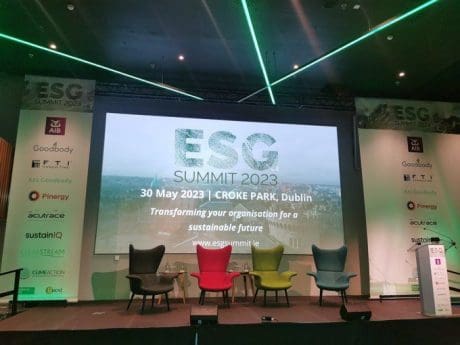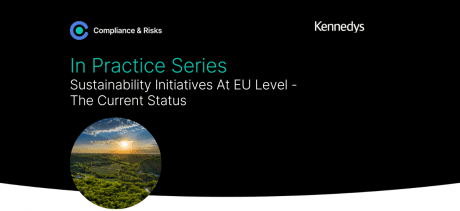
EU Green Claims Directive on the Horizon: The latest on the EU Proposal

This blog was originally posted on 24th February, 2023 and updated on 4th September, 2025. Further regulatory developments may have occurred after publication. To keep up-to-date with the latest compliance news, sign up to our newsletter.
AUTHORED BY EMILIA ASSENZA, SENIOR REGULATORY COMPLIANCE SPECIALIST & TEAM LEADER, COMPLIANCE & RISKS
The Latest on the Proposed EU Green Claims Directive
The primary intent of the proposed Green Claims Directive is to provide uniform rules across the EU specifically dedicated to environmental claims with regard to business-to-consumer commercial practices. The new rules will contribute to fighting greenwashing, by creating a unified framework along with the already enacted Greenwashing Directive 2024/825.
The EU Green Claims Directive has been under discussion since March 2023, when the EU Commission published the first draft. Since then, the initial draft was firstly examined by the EU Parliament in March 2024 with the publication of its position and then, in July 2024, by the EU Council’s general approach.
In January 2025, trilogue negotiations among the EU institutions started, which were expected to be concluded at the end of June 2025. Unfortunately, so far, an agreement on the contents of the Directive hasn’t been reached yet. In fact, prior to the expected final trilogue negotiations scheduled for the end of June 2025, the EU Commission announced its intention to withdraw the Green Claims proposal. A complete withdrawal of an entire piece of legislation, which has been under discussion for over two years, is very unusual and it proves how difficult the legislative process has been, with no agreement reached on several points of the Directive – in particular on the verification process and exemption for microenterprises.
The announcement has been criticised by many stakeholders, given that it will leave greenwashing unregulated. At the end of June 2025, a new statement of the EU Commission appears to suggest that the Directive is still on the table if an agreement on the exemption for microenterprises is reached. It is therefore likely that negotiations will resume in September to hopefully reach a consensus.
The key aspects of the Directive are outlined below, based on the current proposed texts, and bearing in mind that changes may still occur if and when finalised.
Scope
The Directive would apply to all environmental claims on products made available on the market as well as environmental claims made by traders in business-to-consumer commercial practices. The Directive applies to voluntary environmental claims and does not intend to amend any other EU legislation that already establishes requirements in terms of information provided to consumers. It does not apply to environmental labeling schemes or to explicit environmental claims regulated by or substantiated by the listed EU rules (such as the EU Ecolabel). Therefore, this Directive would apply to claims which are not covered by other EU legislation setting out specific rules on the matter.
Definitions
The definition of environmental claim set out in Article 2(o) of Directive 2005/29/EC as amended by [COM(2022) 143final] and the definition of the business-to-consumer commercial practice as defined in Article 2(d) of Directive 2005/29/EC shall apply.
The definitions are as follows:
- ‘Environmental claim’ means any message or representation, which is not mandatory under Union law or national law, including text, pictorial, graphic or symbolic representation, in any form, including labels, brand names, company names or product names, in the context of a commercial communication, which states or implies that a product or trader has a positive or no impact on the environment or is less damaging to the environment than other products or traders, respectively, or has improved their impact over time.
- ‘Business-to-consumer commercial practices’ means any act, omission, course of conduct or representation, commercial communication including advertising and marketing, by a trader, directly connected with the promotion, sale or supply of a product to consumers.
Further definitions are provided in Article 2 of the draft and are aligned, as far as relevant, with the definitions included in other EU legislation (e.g. Unfair Commercial Practices Directive).
Substantiation of Environmental Claims
According to the existing drafts available, including the EU Council’s general approach, Member States must ensure that environmental claims made as regards products or traders are substantiated based on the minimum criteria detailed in Article 3.
Member States must ensure that traders carry out an assessment to substantiate explicit environmental claims.
Claims must rely on widely recognised scientific evidence, use accurate information and take into account relevant methods and international standards. Also, it must be demonstrated that environmental characteristics that are subject to the claim are significant from a life-cycle perspective.
The revised draft of the EU Council also adds a paragraph 1a to Article 3 which expands the requirements when an explicit environmental claim regarding the trader is related to climate, including those based on the use of carbon credits.
Verification of Environmental Claims
The EU Council’s general approach confirms the basic rule of ex-ante verification of environmental declarations and environmental labels.
Member States are required to set up procedures to verify compliance of environmental claims, labeling schemes and the corresponding label with the provisions of EU Directive.
The verification shall be undertaken by a verifier before the environmental claim is made public or the environmental label is displayed by a trader. As per Article 11, the verifier shall be a third-party conformity assessment body accredited in accordance with Regulation (EC) No 765/2008. Further requirements of the verifiers are listed in paragraph 3 with regard to independence, professional integrity, technical competence etc. Upon completion of the verification, the verifier shall draw up a certificate of conformity certifying that the explicit environmental claim or the environmental labeling scheme and corresponding label complies with the requirements set out in this Directive.
The proposal of the EU Council also imposes notification obligations on verifiers for submitting and communicating the certificate to the national competent authorities.
The Commission is empowered to adopt implementing acts to specify the format of the certificate of conformity and the technical means for issuing and notifying such certificate.
Also, a new Article 3a was added by the Council to establish a simplified procedure for substantiation to exempt certain claims from third-party verification. This procedure would apply to claims which have already been certified under an eco-label or which comply with the substantiation methodology of another EU Act. The Commission is also entitled to adopt implementing acts to specify the types of claims to which the simplified procedure may apply, provided that:
- No full life-cycle assessment is required to substantiate the claim;
- The claim is related to a single environmental characteristic;
- The claim does not concern an environmental characteristic that leads to significant trade-offs between different environmental impact categories.
Communication of Environmental Claims
Commercial communication of explicit environmental claims must meet the requirements detailed in Article 5, which include inter alia:
- Environmental aspects, impacts or performance must be assessed in accordance with Article 3;
- Positive environmental impacts, aspects or performance shall not be made if they’ve been achieved through a significant negative increase of any other environmental impact or aspect, unless the negative increase is transparently communicated;
- If the environmental claim is related to a final product, and the use phase is among the most relevant life cycle stages, it shall include information on how the user of the product may relevantly contribute to decrease the environmental impacts of that product in line with the environmental claim;
- Information on the assessment on which the environmental claim is based shall be made available together with the claim (through a weblink, QR code or equivalent).
Environmental Labels
The draft contains specific requirements on environmental labeling, with the primary objective of reducing the proliferation of environmental labeling with insufficient verification and/or certification procedures.
These requirements are complementary to those established by Directive (EU) 2024/825 with regard to sustainability labels.
Environmental label is in fact defined as a sustainability label covering only or predominantly environmental aspects of a product, a process or a trader. The definition of sustainability label is then taken from Article 2, point q) of Directive 2005/29/EC – as introduced by Directive (EU) 2024/825 – which includes “any voluntary trust mark, quality mark or equivalent, either public or private, that aims to set apart and promote a product, a process or a business with reference to its environmental or social aspects or both. This does not cover any mandatory label required in accordance with Union or national law”.
Environmental labels must fulfill the requirements set out in Article 8.
An environmental label shall be based on an environmental labeling scheme. Environmental labeling scheme means a certification scheme that certifies that a product, a process or a trader complies with certain requirements and that allows for the use of a corresponding environmental label.
The requirements of environmental labeling schemes include the following:
- Transparency and accessibility of information on ownership, decision-making and objectives;
- The criteria underlying the award of labels are developed by the environmental labeling scheme owner in consultation with experts and stakeholders;
- The environmental labeling scheme must have a complaint and dispute resolution mechanism in place.
The revision proposed by the EU Council supplements this Article with the verification conditions for environmental labeling schemes in order to ensure they are reliable.
The EU Council has also proposed an exemption for national or regional EN ISO 14024 type I ecolabelling schemes officially recognised in the Member States. Those schemes would be exempted from verification in accordance with Article 10 provided that they comply with the requirements of the Directive. Furthermore, Member States are called upon to set up procedures for the official recognition of such schemes.
Once officially recognised, the EN ISO 14024 type I ecolabel can be used by awarded traders without going through the assessment as per Article 3(a)(2).
Enforcement
Finally, the draft outlines the enforcement procedures, including the designation of competent authorities by Member States for inspection, investigation and monitoring.
National authorities shall carry out regular checks on claims and labeling schemes. When an infringement is detected, they must notify the trader who must take without delay the appropriate actions to cease non-compliance.
Member States are also called upon to lay down the rules on penalties applicable to infringements of national provisions adopted pursuant to the Directive.
The penalties included in the proposals of both the EU Commission and the EU Parliament are as follows:
- Fines at least 4% of a company’s annual turnover in the relevant Member State;
- Confiscation of revenues gained from a transaction with the relevant products concerned;
- Temporary exclusion from public procurement processes and access to public funding for a maximum period of 12 months.
However, it is worth noting that the EU Council has removed the above details on the types of penalties, thus leaving it to the discretion of each Member State.
What to Expect Next?
If negotiations resume in September – with Denmark holding the new EU Council presidency – the main points to be discussed will likely remain the exemptions for microenterprises and the simplification of the verification process. In the meantime, companies must continue to substantiate environmental claims under the EU Unfair Commercial Practices Directive. Also, it is important to bear in mind that, regardless of the finalisation of the Green Claims Directive, unsubstantiated claims are already risky under existing Member States’ consumer protection laws.
It is also worth noting that the exact transposition timeline for Member States is not certain yet. In fact, the EU Council has revised this deadline by extending the application date for Member States to 3 years from the entry into force of the Directive.
To date, what is certain is that businesses must be ready to redefine their practices and put in place internal processes to review their claims and environmental information, in line with the existing and upcoming set of EU rules.
Stay Ahead Of Regulatory Changes
Accelerate your ability to achieve, maintain & expand market access for all products in global markets with C2P – Your key to unlocking market access, trusted by more than 300 of the world’s leading brands.
C2P is an enterprise SaaS platform providing everything you need in one place to achieve your business objectives by proving compliance in over 195 countries.
C2P is purpose-built to be tailored to your specific needs with comprehensive capabilities that enable enterprise-wide management of regulations, standards, requirements and evidence.
Add-on packages help accelerate market access through use-case-specific solutions, global regulatory content, a global team of subject matter experts and professional services.
- Accelerate time-to-market for products
- Reduce non-compliance risks that impact your ability to meet business goals and cause reputational damage
- Enable business continuity by digitizing your compliance process and building corporate memory
- Improve efficiency and enable your team to focus on business critical initiatives rather than manual tasks
- Save time with access to Compliance & Risks’ extensive Knowledge Partner network
Book Time With Our Team
Learn how C2P can help you stay ahead of global Apparel regulatory changes and achieve uninterrupted market access.


